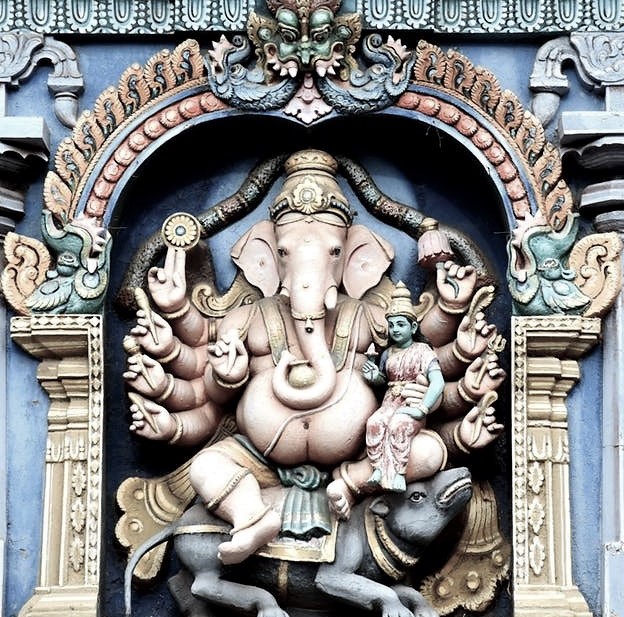- Special FeaturesFoundation Year1st century ADSthala TreeTheerthamRathamArchitectureBuddhist vihara caveOther SpecialityThe Ganesha temple is located in Cave 7, the largest excavation around Junnar, about 30 metres (98 ft) above the plains. It is essentially a Buddhist Vihara (a dwelling for monks, mostly with meditation cells) in design, an unpillared hall with 20 cells with varying dimensions; 7 on either side and 6 on the rear wall. The hall is large, can be entered by a central door, under a pillared veranda. The hall is 17.37 metres (57.0 ft) long; 15.54 metres (51.0 ft) wide and 3.38 metres (11.1 ft) high. There are 2 windows on either side of the entrance. The hall is treated now as a sabha-mandapa ("assembly hall") of the Ganesha temple. 283 steps built (by devotees) in stone masonry over eight flights lead to the entrance. The steps are believed to represent sensual pleasures, which Ganesha has overcome. The veranda has six pillars and two pilasters (half-pillars), that support "an architrave from which projects eaves relieved with a railing resting on beams and rafters". The pillars have octagonal shafts and "over benches and backrest and topped by an inverted ghata, compressed amalaka in between two square plates, inverted stepped pyramid and finally crowned by a bracket" with tigers, elephants and bulls. In a later period, the two central cells of the rear wall have been combined by breaking the partition in between to house the Ganesha image. The old entrance was also widened during the conversion to the Ganesha temple. There are two other smaller entrances to the hall. All entrances bear marks of sockets for fixing wooden doors, added during the conversion, and still have doors. The hall also has traces of plaster and paintings, both added during the conversion and renewed in later times - possibly as late as the 19th century. The Gazetteer of the Bombay Presidency (1882) records that the hall was plastered and white-washed. The paintings depicted Ganesha's childhood, marriage preparations, battle with demons and so forth, along with scenes of other Hindu deities like Devi, Krishna, Vishnu and Shiva.
- Sthala Puran
According to the Ganapatya scripture Ganesha Purana, Ganesha incarnated as Mayuresvara or Mayureshwar (Mayūreśvara), who had six arms and a white complexion. His mount was a peacock. He was born to Shiva and Parvati in the Treta yuga, for the purpose of killing the demon Sindhu.
Once Parvati (Girija) asked her husband Shiva who he was meditating on. He said he was meditating on "the supporter of the entire universe" - Ganesha, and initiated Parvati with the Ganesha Mantra "Gam". Desiring to have a son, Parvati underwent austerities meditating on Ganesha, for twelve years at Lenyadri. Pleased by her penance, Ganesha blessed her with the boon that he will be born as her son. Accordingly, on the fourth lunar day of the bright fortnight of the Hindu month Bhadrapada (Ganesh chaturthi day), Parvati worshipped a clay image of Ganesha, which came alive. Thus, Ganesha was born to Parvati at Lenyadri. Later, he was named Gunesha by Shiva. Shiva gave him a boon that whosoever remembers him before starting a job, will successfully complete that task. For 15 years Gunesha grew up at Lenyadri. Sindhu, who knew that his death would be at the hands of Gunesha, sent demons like Krur, Balasur, Vyomasur, Kshemma, Kushal, and many more, to kill Gunesha, but all of them were instead killed by him. At the age of six, the architect-god Vishwakarma worshipped Gunesha and endowed him with the weapons Pasha (noose), Parashu (axe), Ankusha (hook) and Padma (Lotus). Once, little Gunesha knocked an egg from a mango tree, from which emerged a peacock. Gunesha mounted the peacock and assumed the name Mayuresvara. Mayuresvara later killed Sindhu and his army-generals at Morgaon, the most important Ashtavinayaka temple.
- Architecture
The Ganesha form worshipped here is called Girijatmaja (Sanskrit: गिरिजात्मज). The name is either interpreted as "mountain-born" or as "Atmaja of Girija", the son of Parvati, who herself is the daughter of the mountain Himavan, a personification of the mountains of Himalayas. The features of the Ganesha icon, seen on the back wall of the cave, are the least distinct vis-a-vis the other Ashtavinayak temples. Though the temple faces the inauspicious south, - according to a local tradition - the deity faces north, with his back to his worshipper and his face visible on the other side of the mountain. The Peshwa rulers even tried in vain to locate the face of Ganesha on the other side. The central icon was covered with brass-plated wooden armour, given as a gift by Junnar. The armour is not present currently. After it was removed, Ganesha could be seen with his trunk turned to the left side, facing east, with one of his eyes visible. The icon is covered with sindoor and is directly formed/sculpted on the stone wall of the cave.
Like all Ashtavinayaka temples, the central Ganesha image is believed to be swayambhu (self-existent), a naturally occurring stone formation resembling an elephant face.
- Alankar of Deity
- Prayers and BenefitsSpecial Vratas and PrayersOfferings to DeityStotras and Mantras
- FestivalsThe festivals of Ganesh Jayanti and Ganesh Chaturthi are celebrated in the temple, when pilgrims crowd all Ashtavinayak temples
- Sodasha Upcharas
- Prasadhas
- Social ActivitiesAnnadhanMarriageEar BoringHead ShaveDanaasEducation FacilitiesSocial DrivesOther Activities
- Arjita Seva
- Tags

